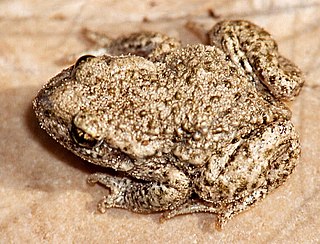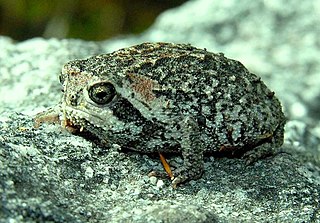
Midwife toads are a genus (Alytes) of frogs in the family Alytidae, and are found in most of Europe and northwestern Africa. Characteristic of these toad-like frogs is their parental care; the males carry a string of fertilised eggs on their backs, hence the name "midwife". The female expels a strand of eggs, which the male fertilizes externally. He then wraps them around his legs to protect them from predators in the water. When they are ready to hatch, the male wades into shallow water, where he allows the tadpoles to leap out of their eggs. Five separate species of midwife toads are found across western Europe, northern Africa, and Majorca.

Breviceps is a genus of frogs in the family Brevicipitidae. Species in the genus Breviceps are commonly known as rain frogs or short-headed frogs. They occur in arid to semiarid climates of Eastern and Southern Africa.

The desert spadefoot toad is a species of frog in the family Limnodynastidae. It is endemic to Australia. Its natural habitats are subtropical or tropical dry shrubland, subtropical or tropical dry lowland grassland, intermittent freshwater marshes, hot deserts, and temperate desert.

Breviceps adspersus, also known as common rain frog, bushveld rain frog, and many other vernacular names, is a species of frog in the family Brevicipitidae. It is found in Southern Africa, in Angola, Democratic Republic of the Congo, Namibia, Botswana, Zambia, Zimbabwe, South Africa, Eswatini, and Mozambique.

Bilbo's rain frog is an amphibian species in the family Brevicipitidae, endemic to South Africa. The frog was named after Bilbo Baggins, the main character from The Hobbit by J.R.R Tolkien. The frog was named as such because the scientist who discovered it used to read the novel to his children. Its natural habitats are temperate grasslands and edges of wood plantations, wherein it spends most of its time in its burrow. The species is threatened by construction, maintenance of roads, silviculture, general habitat degradation/habitat loss, and by road traffic. As a result, it is listed as Near Threatened in the IUCN Red List of Threatened Species.

Breviceps fuscus, also known as black rain frog, plain rain frog, brown short-headed frog, and Tsitsikamma rainfrog, is a species of frogs in the family Brevicipitidae. It is endemic to the southern coast of South Africa.

The cape rain frog or giant rain frog is a species of frog in the family Brevicipitidae. Adults grow up to 45 mm in length. It was the first African frog species to be scientifically described by Carl Linnaeus in 1758, under the name Rana gibbosa. It is the most common and largest of rain frogs. The name "rain frog" that is applied to the genus refers to a belief that these frogs bring rain.

The mountain rain frog is a species of frogs in the family Brevicipitidae.

The Mozambique rain frog, also known as the flat-faced frog, is a species of frog in the family Brevicipitidae. It is found in Botswana, Democratic Republic of the Congo, Eswatini, Malawi, Mozambique, South Africa, Tanzania, Zambia, Zimbabwe, and possibly Lesotho. Its natural habitats are dry savanna, moist savanna, temperate shrubland, subtropical or tropical dry shrubland, temperate grassland, subtropical or tropical dry lowland grassland, subtropical or tropical high-altitude grassland, arable land, pasture land and rural gardens.

The Namaqua rain frog or Namaqua short-headed frog is a species of frogs in the family Brevicipitidae. It is found in Namaqualand in western South Africa and extreme southern Namibia.

Rose's rain frog or Rose's rainfrog is a species of frog in the family Brevicipitidae. It is endemic to the sandveld of south-western coastal South Africa. It is less-frequently known as Rose's short-headed frog, Rose's Blaasop, or the sand rain frog. Some treat Breviceps fasciatus as a synonym of this species, although other authorities have expressed doubt.
The whistling rain frog is a species of frogs in the family Brevicipitidae. It is found in South Africa, Eswatini, and possibly Mozambique. Its natural habitats are temperate forests, dry savanna, moist savanna, and sandy shores. It is threatened by habitat loss.

The forest rain frog is a species of frog in the family Brevicipitidae. It is endemic to Limpopo, South Africa. Two allopatric subspecies are recognized: the nominate one, Breviceps sylvestris sylvestris, and Breviceps sylvestris taeniatusPoynton, 1963 from near Soutpansberg. Its natural habitats are temperate forests, temperate grassland, and rural gardens. It is threatened by habitat loss.

The plaintive rain frog or rough rain frog is a species of frog in the family Brevicipitidae. It is found in Lesotho, South Africa, and Eswatini. Its natural habitats are temperate forests, dry savanna, temperate shrubland, temperate grassland, and rural gardens. It is threatened by habitat loss.

Scaphiophryne marmorata is a species of frog in the family Microhylidae. It is commonly known as the green burrowing frog and the marbled rain frog. It is endemic to Madagascar. It is classified as "Vulnerable" by the IUCN as it is threatened by habitat loss.

Müller's platanna, also known as Müller's clawed frog, is a species of frog in the family Pipidae found in Angola, Benin, Botswana, Burkina Faso, Cameroon, the Central African Republic, Chad, the Republic of the Congo, the Democratic Republic of the Congo, Ivory Coast, Eswatini, Ghana, Kenya, Malawi, Mozambique, Namibia, Nigeria, South Africa, Sudan, Tanzania, Togo, Uganda, Zambia, and Zimbabwe.

Brevicipitidae or rain frogs is a small family of frogs found in eastern and southern Africa. As of 2020 contains 37 species in 5 genera. Formerly included as subfamily in Microhylidae, phylogenetic research has indicated the brevicipitine frogs should be considered as a family with Hemisotidae as the most closely related sister taxon.

Lycodonomorphus inornatus, commonly known as the olive house snake, the black house snake, and the olive ground snake, is a species of nonvenomous snake in the family Lamprophiidae. The species is endemic to southern Africa. It is a nocturnal snake with terrestrial habits.
Breviceps branchi or Branch's rain frog is a species of frogs endemic to South Africa in the Breviceps genus of frogs.

















